Exercises (3201)
Footwork: slalom
Light-Contact
Individual work
A slalom is run between stakes in double coverage (do not cross your feet but keep them shoulder-width apart).
Variant:
Competition form against another participant (optioanl: the slower one does 5 push-ups/torso bends/extension jumps).
7/14 stakes
Move your legs to the side while sitting alternately
Power
Individual work

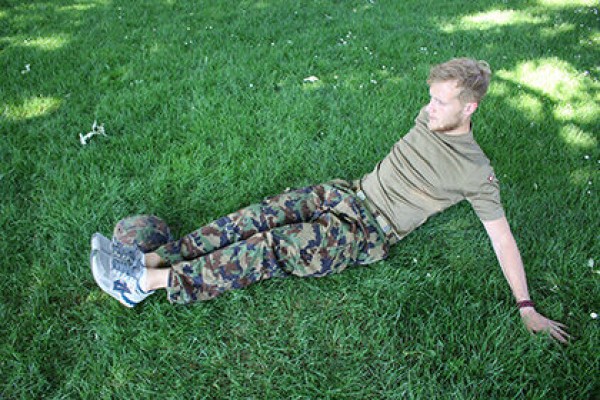
Sit on the floor, upper body slightly tilted backwards and supported by the hands, legs slightly raised from the floor in front of you and almost stretched out, alternately move the legs sideways over an object placed at foot level (e.g. helmet or rucksack), briefly tapping the floor with the heels on each side. Alternate legs sideways over an object (e.g. helmet or rucksack) placed at foot level, briefly touch the ground with your heels on each side.
Attention:
Do not put your feet down.
Lighten:
Legs bent more strongly.
Harden:
Legs extended; additional weight on/between the legs.
1 helmet/fighting rucksack
2 weight cuffs/1 PET bottle (1.5 litres)/ball/(additional) helmet/fighting rucksack ► make the exercise more difficult (additional weight)
Move your legs to the side while sitting alternately
Power
Individual work
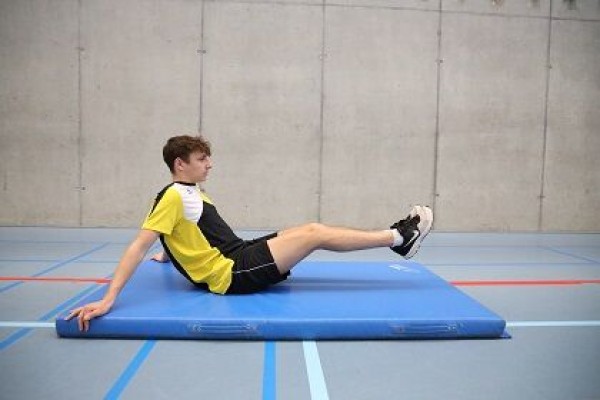

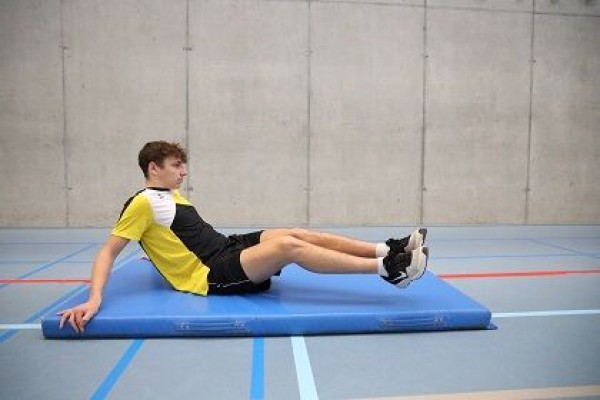
Sit on the floor, upper body tilted slightly backwards and supported by the hands, legs slightly raised from the floor in front of you and almost stretched out, alternate legs from one side to the other (optionally tap the floor briefly with your heels on each side).
Caution:
Do not put your feet down.
Lighten:
Bend your legs more.
Harden:
Legs stretched out; additional weight on/between the legs.
2 weight cuffs/1 (medicine) ball/weight disc/dumbbell ► make the exercise more difficult (additional weight)
Sequence of movements
Floor and apparatus gymnastics
The participants demonstrate a defined (or self-selected) sequence of movements to the sports leader (the group). The movements are practised by the participants beforehand.
Example of a possible combination:
- Forward roll
- Jump roll from standing position
- Stand balance
- Stretch jump with half turn
- Backward roll
- Handstand with roll-off
6-8 soft mats (small)
Movement tasks
Stimulate circulation
Group work
The participants move freely in the hall/area while carrying the ball, with the sports instructor specifying various exercises. Here is a possible selection of exercises:
Ball on the foot:
- Carry the ball only with the left/right foot (inside/outside instep)
- Carry the ball sideways with the sole (left/right)
- Carry the ball between the legs
- Carry the ball backwards with the sole (left/right)
Ball in the hands:
- Bounce the ball with the right/left hand only
- Bounce the ball high/low but constantly guided (left/right)
- Roll the ball (left/right hand)
- Pass the ball behind the back every few steps using a ground pass (from left to right hand and vice versa)
- Pass the ball between the legs every few steps or at each step (from left to right hand and vice versa)
Additional tasks:
On a signal from the sports director (e.g. 1-4 whistles)e.g. 1-4 whistles), the participants perform various defined exercises. Here is a possible selection of exercises that can be assigned to the signals. During the execution of an additional exercise, the sports leader can announce the next form of ball handling.
- Four jumps over the ball (both legs)
- Touch the ball with the buttocks
- Touch the ball with the chest
- Wall pass
- Stop/put the ball down and look for a free ball
- Swap the ball with another participant
- Tap the ball alternately with the tips of the feet (3 times each)
- Stop the ball, Sprint to a defined place and back to a free ball (variant: The sports leader removes one or more balls during the sprints. Anyone who can no longer find a ball performs an additional task such as stretch jumps or push-ups).
Per participant:
1 ball
Sport leader:
1 signalling instrument (e.g. hand whistle, tambourine)
Movement tasks
Stimulate circulation
Group work
The participants move freely around the hall/area with a skipping rope, with the instructor specifying various exercises. Here is a possible selection of exercises:
In motion:
- Only right leg first (with/without intermediate step)
- Only left leg first (with/without intermediate step)
- Alternating right/left leg first (with/without intermediate step)
- Both legs
- Mixed forms (e.g. twice both legs-left leg first-right leg first, etc.).)
- All of the above exercises in a backward motion
On the spot:
- Jump sideways to the right and left, keeping your feet and knees parallel at all times (variation: jumping in a square)
- Jumping on the spot, alternately rotating the hips against the upper body, knees pointing towards the tips of the feet
- Sliding and closing the legs
- Jumping alternately with the feet in a stepping position, knees and tips of the feet pointing straight ahead (with/without intermediate jump)
- Combination of straddles and lunges
- Alternately lifting the knees as high as possible, the upper body should remain upright and slightly forward (with/without intermediate jump)
- Alternately tap the right/left heel at the front (with/without intermediate jump)
- Alternately tap the toes at the back (with/without intermediate jump) tap (with/without intermediate jump)
- combination of front heel/back toe tap
- alternating kick with one foot forwards/backwards
- Arms crossed (continuously or every few jumps, also possible swinging backwards)
- Cross your legs and open them again (alternating right/left foot forwards), knees pointing outwards
- Double jump (the rope swings twice in one jump)
- Single-leg jump right/left with kicking movements if necessary, Heel or toe taps with the other foot
- Sitting and swinging the halved rope over your head and occasionally pulling the rope under your buttocks
Participant:
1 skipping rope
Movement tasks
Stimulate circulation
Group work
The participants move freely with the ball (forwards, backwards, sideways, with speed variation) in the hall/area, with the sports instructor specifying various movement tasks. The exercises should be performed with both the stronger and the weaker side. Here is a possible selection of exercises:
- Balancing the ball on the racket
- Juggling the ball with the racket (forehand and backhand side as well as racket edge)
- Bouncing the ball on the ground
- Catching/stopping the ball every few steps with the racket in the air as well as on the ground
- Rolling/guiding the ball on the ground
Participant:
1 bat (Smolball)
1 ball (Smolball)
Movement tasks
Stimulate circulation
Group work
One column (distance approx. 1 metre from participant to participant)
The participants move in a circle, the sports leader walks in the opposite direction to demonstrate the movement tasks.
The participants jog a few easy laps in the hall/outdoors (1 person column, distance approx. 1 metre). The instructor runs in the opposite direction and demonstrates various exercises that the participants integrate into their running. Here is a possible selection of exercises:
- Circle arms left/right forwards/backwards; circle arms offset/parallel forwards/backwards
- Side straddle run (hop sideways, pull back the rear leg), simultaneously stretch arms out to the side and bring them together above the head (jumping jack). 3-4 executions then change front direction.
- Crossover run (move sideways while crossing your legs). 3-4 executions then change front direction. The arms are bent in front and swing from one side to the other according to the movement.
- Hop run (swinging arm on the opposite side of the bent knee in a high position)
- Knee lift / heel lift
- On a signal (e.g. 1-2 whistles), perform an exercise (e.g. 1-2 whistles). 1-2 whistles) to perform an exercise (e.g. stretch jump, touch the floor or push-ups)
- Other options (e.g. turning leg in/out)
Sport leader:
1 signalling instrument (e.g. hand whistle, tambourine)
Movement tasks
Stimulate circulation
Group work
The participants move freely (forwards, backwards, sideways, with variations in speed) in the hall while carrying the ball. At a signal from the sports instructor (e.g. 1-4 whistles), the participants perform various defined exercises. Here is a possible selection of exercises that can be assigned to the signals:
- Execute a figure eight on the spot with the ball between the legs
- Five wall passes
- Lift the ball over a line twice with the forehand and backhand side
- Lift the ball and balance it on the shovel for a few seconds
- Deposit the racket and ball on the floor. Jump over the stick five times with both legs and then look for another stick (same side) with ball.
- The participants try to balance the stick for a few seconds on different parts of the body (e.g. foot, palm, back of the hand, head, nose, elbow, fingers, etc.)
- The participants place the stick on the floor and try to balance on it for a few seconds.
Per participant:
1 stick (floorball)
1 ball (floorball)
Sports leader:
1 signalling instrument (e.g. hand whistle, tambourine)
Movement tasks
Stimulate circulation
Group work
The participants move freely in the terrain, with the sports leader specifying various forms of movement. Possible forms of movement are:
- Diagonal stride (possibly with double pole use)
- Hop run
- Arms held high or in front
- Forwards movement in the lowest possible position (knees bent/deep gait)
On a signal from the sports leader (e.g. 1-4 whistles), the participants perform various defined exercises. Here is a possible selection of exercises that can be assigned to the signals:
- Place sticks on the floor. Jump over the stick 5 times with both legs.
- The participants try to balance a stick on different parts of the body for a few seconds (e.g. foot, palm, back of the hand, head, nose, elbow, fingers, etc.)
- The participants place the sticks on the floor and try to balance on them for a few seconds (variation: keep their balance on a stick)
Per participant:
1 pair of poles (Nordic walking)
Sport leader:
1 signalling instrument (e.g. hand whistle, tambourine)
Movement tasks
Stimulate circulation
Group work
Single column (distance approx. 1 metre from participant to participant)
The participants jog a few easy laps in the hall/outdoors (1 person column, distance approx. 1 metre). The sports instructor demonstrates various exercises at the front, which the participants integrate into their running. Here is a possible selection of exercises:
- Arm left/right circling forwards/backwards; Circle arms offset/parallel forwards/backwards, swing arms at chest height from one side to the other
- Integrate kicks into running (straight, sideways hook, upwards hook - also combo)
- Knee lift / heel lift (every few steps, on every step)
- Lateral running, where the feet do not cross and never touch (side straddle run) - also integrate kicks
- Crossover run - turn leg in (back) and turn leg out (front) as a single exercise or in combination
- Hop run (swing arm on the opposite side of the bent knee in high hold)
- Footwork: Block, foot kick, knee kick (every few steps, on every step - also combo)
- Tiptoe stand on one leg, lunge, place hand on the floor, turn upper body in/out with the free arm - then switch sides / perform exercise identically with the other hand supporting the upper body
- Shift in forearm support / in push-up position (integrate rotations around the body axis)
No material required
Movement tasks
Forms of play / exercises
Group work
The participants move freely with the ball (forwards, backwards, sideways, with speed variation) in the hall/area, with the sports instructor specifying various movement tasks. The exercises should be performed with both the stronger and the weaker side. Here is a possible selection of exercises:
- Balancing the ball on the racket
- Juggling the ball with the racket (forehand and backhand side as well as racket edge)
- Bouncing the ball on the ground
- Catching/stopping the ball every few steps with the racket in the air as well as on the ground
- Rolling/guiding the ball on the ground
Participant:
1 bat (Smolball)
1 ball (Smolball)
Biathlon-Stafette
Increase pulse
Group work
5-6 participants per group
The participants run around a turning point (e.g. drawing stick, marker cone or cone) or touch a wall and have to fulfil a throwing task on the way back (hitting a target from a certain distance). Each participant carries the throwing object with them during the run. If the throwing task is not completed, the route to the turnaround point (to the wall) must be completed again before returning to the group and the next participant can start running. In the event of a successful attempt, the runner can run directly to the group.
The thrown object is picked up and carried by the runner both in the event of a hit and a miss.
Possible targets:
- Upside-down box
- Ripe
- Mat
- Painting stick
Possible throwing object:
- Ball
- Indiaca
- Howler
- Frisbee
- Maturity
Variant:
Change the distance between throws or the number of attempts.
Per group:
2 colouring sticks
1 target
1 throwing object
Big Jump
Parkour
Individual work


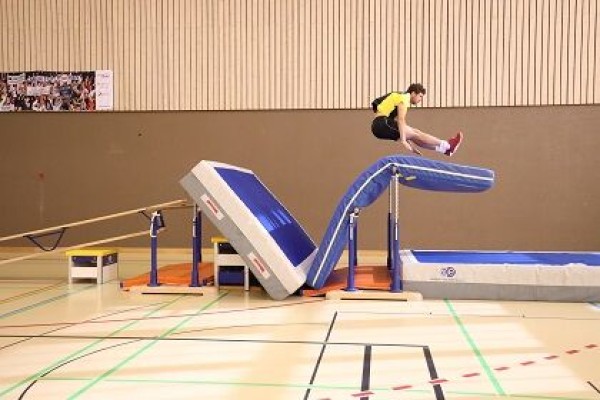
Approach over the long bench, jump onto/over the soft mat further away.
1 long bench
2 parallel bars
2 vaulting box
3 soft mats (large)
2 soft mats (small)
4 skipping ropes
Post set-up:
Exercise set-up as shown; the large soft mats are tied to the parallel bars.
Blind locomotive
Stimulate circulation
Partner work
A couple grasp each other's Nordic walking poles on the side to form a "locomotive". The person behind closes their eyes and the person in front leads the train through the neighbourhood. As soon as the train stops, the person behind tries to guess the location (still with their eyes closed).
Variant:
From time to time, merge the groups into a longer train (groups of 4/6).
Participant:
1 pair of poles (Nordic Walking)
Blitzball - Touchrugby
Games / Tournament
Game idea:
Two teams face each other on a playing field and endeavour to place a rugby ball in the opponent's target area by using their running speed and feinting hooks. The respective ball carrier can be forced by the opposing team to pass the ball backwards to a teammate, who then tries to penetrate the target area.
Scoring points:
A point is scored when an untouched player can place the ball behind the opposite target line in one of the three target areas. The centre target area scores three points, the side fields score 2 points each (indicated by marker cones).
Variant: a large soft mat is placed in the target area (centre); a point is scored by jumping onto the mat.
Playing field:
Field size 50mx34m for 6 players (3 against 3), 70mx48m (12 players), 100mx55m (18 players)
Number of participants:
3 against 3 to 9 against 9, depending on the field size
Rules of the game:
- The game is opened by means of a pass from the centre forward between the straddled legs to the back to a teammate.
- The ball may be carried forwards by any player, but may only be played/passed backwards.
- The player carrying the ball may be forced to pass it by hitting him on the back with his hand. The player in possession of the ball must then pass the ball on the third step or after two seconds at the latest.
- Jostling, clutching and pushing are not permitted, nor is hitting the ball.
- A free throw is awarded for all infringements of the rules, especially if the attacking team passes forwards. The free throw is always taken from the spot where the offence was committed.
- Except for the handshake on the back, Blitzball is played without any form of physical contact.
Blitzball: All against all
Forms of play / exercises
Group work
Two teams play against each other in a given field. The aim is to play as many passes as possible in the team before an opponent can intercept the ball or the ball falls to the ground. Whoever gets a pat on the shoulder from the opponent must pass. If the pass is intercepted or the ball falls to the ground, the ball changes hands and the other team can play the passes. Whoever has played the most passes after a predetermined time wins.
Variant:
10 passes result in one point. If a point is scored, the ball changes hands.
1 rugby ball
x game wristbands / covers ► team identification
Blitzball: Passing in a circle
Forms of play / exercises
Group work
5-8 participants per group (ideally groups of 6)
Each six participants form an outer front circle and pass a rugby ball around the outside of the circle. Round to the right / round to the left / ditto with two balls (aim: catch up with the other ball).
Per group:
2 rugby balls
Blocking
Light-Contact
Partner work
Presentation by leader.
The groups of 2 then practise the movements (including role reversal); the leader corrects them.
One way of blocking from the basic position is simply to turn out the respective hand and bring it forwards (crosswise) in order to ward off/block the attacker's punch with the palm of the hand (fist against palm).
Participant:
1 pair of boxing gloves
Block / evasive manoeuvre with counterattack
Light-Contact
Partner work
Presentation by leader.
The groups of two then practise the movements (including role reversal); the leader corrects. If necessary, an exercise sequence is also performed in the group.
This sequence of movements combines blocking and dodging with a counter (lead hand and punching hand). One participant slowly strikes 4x in the direction of their partner's forehead (2x left/right). The defender blocks the punches twice (left/right) and then dodges twice and simultaneously performs a counter-punch (left/right).
Blocking:
When blocking, the respective hand is turned out from the basic position and brought forward (crosswise) to ward off/block the attacker's punch with the palm of the hand (fist against palm).
Leading hand:
When countering with the leading hand (example left side), the front foot remains stable in place, the weight is shifted to the rear (right) foot (tilt the upper body backwards slightly). To avoid the opponent's punch, the body weight is not only shifted backwards, but the upper body is also tilted to the side (outwards - to the right). Finally, you follow up with your own punch (jab) with the (left) lead hand (on the "inside" side).
Punching hand:
When countering with the punching hand (example right side), you take a step to the (left) side (sidestep), shifting your weight to the front (left) foot. Finally, the own punch (straight) follows with the stronger hand (on the "inner" side).
Exercise:
In groups of 2, the blocking and dodging including the counter punch is practised. This involves blocking and dodging twice on one side and then on the other (lead hand and punching hand). The sequence of movements is practised very slowly at first; the speed can only be increased once the sequence of movements has been completely mastered. The roll can be changed after each pass or after several passes. In order to gain more confidence in the sequence of movements, it is advisable to do several passes in succession. It also makes sense to change partners from time to time (variety and different levels of participants). The instructor can make the exercise more difficult by no longer clearly defining the attacking side (e.g. 2 attacks each to block and evade - side arbitrarily determined by the attacker - change roles - change partners).
Participant A: 2x punch left + right (jab + straight) / Participant B: Block left + right plus dodge with counter (lead hand and punching hand)
Variant:
All participants perform the sequence of movements (= participant B; see above) together (same front - rotate the alignment by 90 degrees after each pass). The instructor counts slowly from 1-4 for the individual steps (block left - block right - dodge incl. counter with the lead hand - dodge incl. counter with the punching hand). The instructor takes the opportunity to make corrections.
Participant:
1 pair of boxing gloves
Blocking with punching hand
Light-Contact
Partner work
Constant role and partner changes
.Position:
Elbows close to the upper body, arms remain where they are in the boxing position, slight shoulder rotation against the punch (3cm).
- Participant A: punch with lead hand
- Participant B: block with punching hand
- Participant A: punch with lead hand, block with punching hand
- Participant B: Block with punching hand, counter with jabbing hand
Variation:
Apply what you have learnt in a short 1:1 match (slowly + carefully; don't hit too hard at the beginning).
Participant:
1 pair of boxing gloves
Boccia
Leakage
Group work
Groups of 4 to 6
Each member of a small group tries to throw one of their shoes as close as possible to a previously defined target (by hand or by foot). The group members receive different numbers of points based on their ranking. Which member of the group collects the most points in a given time.
Variant:
The participants throw one of their shoes as close as possible to the defined target.
Per group:
1 marking cone / cone
Boccia
Leakage
Group work
Groups of 4 to 6
Each participant in a small group tries to pass as close as possible to a previously defined target (e.g. goalpost, tree, candelabra, rings, colouring sticks, cones or similar objects distributed around the room) with their aid. The group members receive different numbers of points based on their ranking. Which member of the group collects the most points in a given time?
Per participant:
1 ball ►FooBaSKILL, futsal/football, intercross/lacrosse, smolball, floorball
1 racket/stick ►badminton/speedminton, intercross/lacrosse, smolball, floorball
1 disc (frisbee) ►Frisbee Ultimate
x targets (e.g. colouring sticks / cones / rings / etc.)
Ground contact
Partner acrobatics
Group work
Groups with 3-10 participants
The participants form groups of 3-10 people. The sports leader specifies the number of limbs that may touch the floor within the group. Through skilful acrobatic exercises and a little ingenuity, the groups fulfil the sports leader's specifications.
No material required
Floor press
Fighting and roughhousing games
Partner work
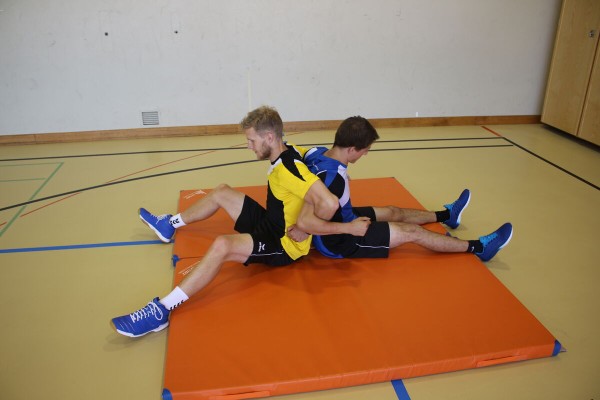
The participants sit back to back with their legs slightly bent in the centre of a mat/lawn area. The participants' arms are interlocked. The aim is to press the opponent's right or left shoulder to the ground. The side is changed with each pass.
2 soft mats (small) ►indoor version
2 tent groundsheets ►outdoor version
Indoor post assembly:
Connect the soft mats to each other on the wide side using Velcro.